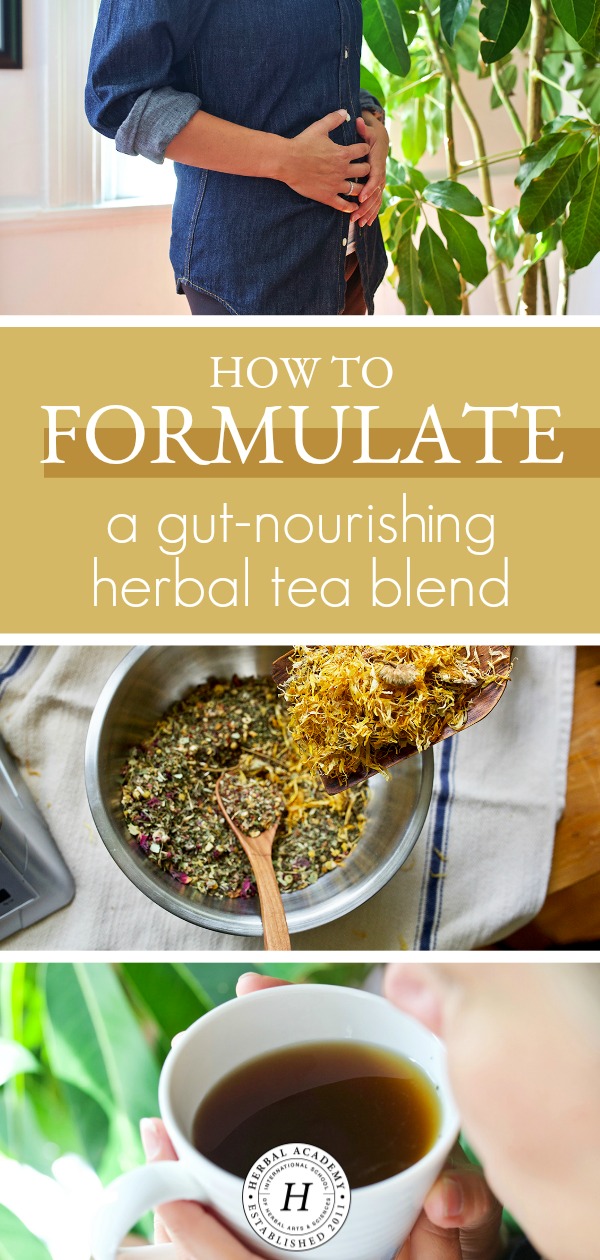
How To Formulate A Gut-Nourishing Herbal Tea Blend
Making a gut-nourishing herbal tea is a tried and true herbal preparation that herbalists of all backgrounds turn to time and time again. As ancient Greek physician Hippocrates proposed so long ago, “all disease begins in the gut.” This insight holds true today since so many health imbalances often have a direct connection to the health of the gut.
Therefore when it comes to addressing complex symptom pictures, supporting a healthy gut is a good place to start. Many herbalists opt for a simple gut-nourishing herbal tea blend to focus on the “root” of many health imbalances, while other formulas and preparations can support the “branches,” or secondary symptoms, along the way. In this article, you will learn how to formulate a gut-nourishing herbal tea blend from start to finish, including different categories of herbs that you can draw from depending on the need at hand.
How To Formulate A Gut-Nourishing Herbal Tea Blend In 3 Steps
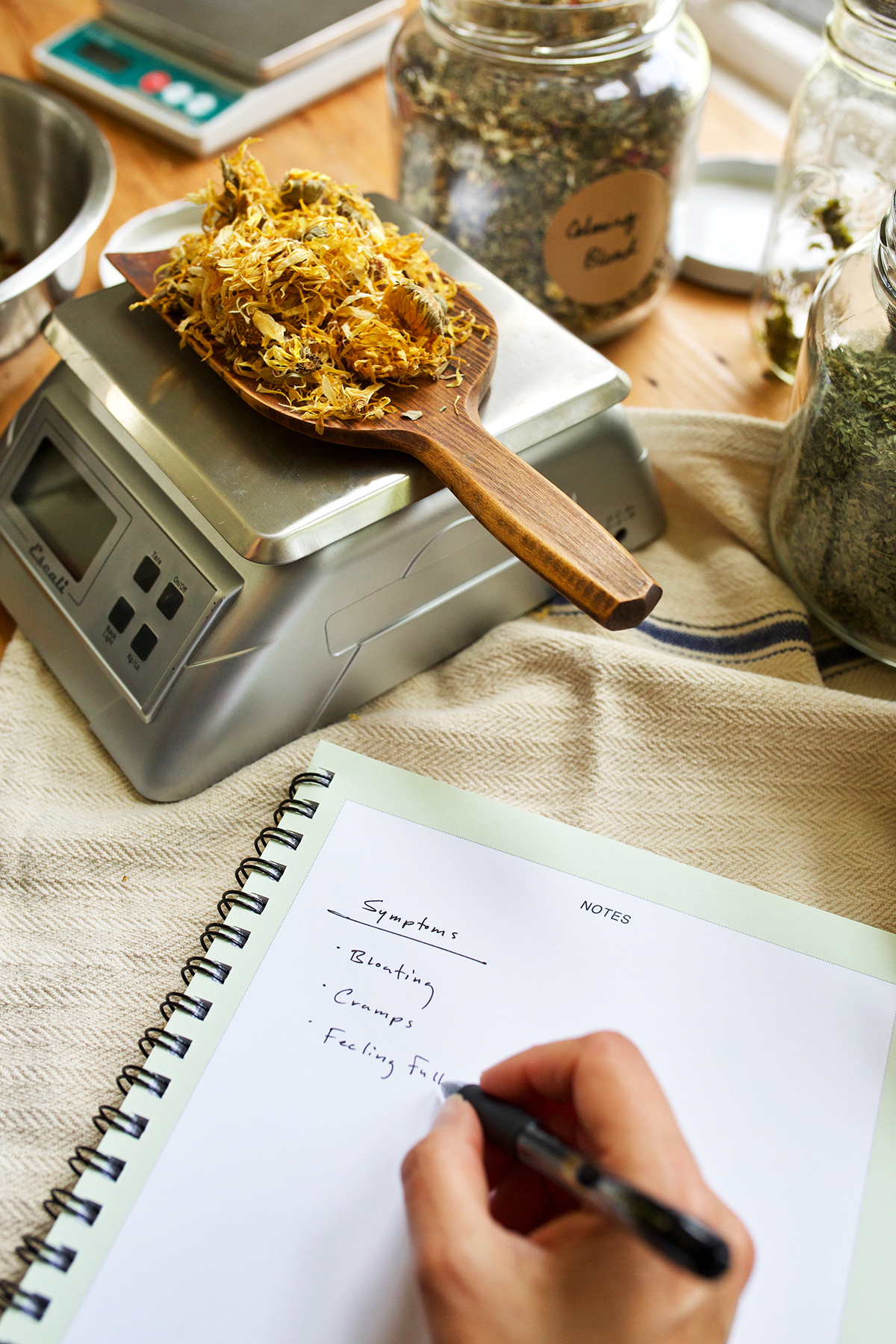
Step 1: Set Your Goals
The first step behind every formulation, including that of a gut-nourishing herbal tea, is to set your goals and objectives for the formula. It’s important not to skip this step as it helps keep your formula focused, making it easier to choose between different herbs. Oftentimes, setting your formula goals can be as simple as choosing certain herbal action categories you wish to focus on primarily. Formula goals can also be focused around an explicit health goal you are working towards.
It is often helpful to choose primary, secondary, and tertiary goals for each formula you create. Try not to exceed three goals per formula since going beyond three can start to diminish the primary focus of the formula. For example, the goals of your gut-nourishing herbal tea formula could be: to support the gut after a bout of food poisoning, utilize astringent herbs (to help regulate loose bowels), and soothe gas and bloating symptoms.
If you are unsure of what your goals might be or how to focus your formula, start by listing all of the symptoms you wish to address and then evaluate the different ways a gut-nourishing herbal tea could support them. You can also reference the list of Herbal Action Categories in the section below to source formulation inspiration.
Step 2: Identify Appropriate Herbal Action Categories
Once you set the goals for your formula, it’s time for the fun part: choosing which herbs to use! Use the herbal action categories below as a helpful reference tool when building your gut-nourishing herbal tea formula. Since there are many different purposes and unique goals for which gut teas may be formulated, not all of the herbs or herbal action categories listed below will be pertinent to every formula.
Remember to keep in mind the accessibility of certain herbs in your area (or home apothecary) and the general taste of your tea formula as you go. Although it might be tempting to include as many herbs as possible in your formula (since every herb is so unique and has so many amazing properties!), try to limit your formula to no more than seven herbs. Using too many herbs in one formula can start to decrease the effectiveness of the formula.
The last category in the list provides a few flavor-enhancing herbs (some of which have some crossover in the various gut-supportive categories as well). Have fun incorporating one or two different flavor-enhancing herbs into each herbal tea blend to find the perfect flavor that suits your taste buds.
- Gut Lining and Tissue Support (vulneraries): plantain (Plantago spp.), chamomile (Matricaria chamomilla), calendula (Calendula officinalis), gotu kola (Centella asiatica), slippery elm (Ulmus rubra), cleavers (Galium aparine), marshmallow (Althaea officinalis)
- Inflammation Modulation (anti-inflammatory): turmeric (Curcuma longa), ginger (Zingiber officinale), rosemary (Rosmarinus officinalis), calendula (Calendula officinalis), chamomile (Matricaria chamomilla), fennel (Foeniculum vulgare), self heal (Prunella vulgaris), sage (Salvia officinalis)
- Demulcent and Moistening Herbs: marshmallow (Althaea officinalis) leaf or root, plantain (Plantago spp.), slippery elm (Ulmus rubra), chickweed (Stellaria media), hollyhock (Alcea rosea), licorice (Glycyrrhiza glabra)
- Cramping Support (antispasmodics): wild yam (Dioscorea villosa), chamomile (Matricaria chamomilla), catnip (Nepeta cataria), ginger (Zingiber officinale), fennel (Foeniculum vulgare)
- Astringent Herbs: agrimony (Agrimonia spp.), raspberry (Rubus officinalis) leaf, rose (Rosa spp.), bacopa (Bacopa monnieri), Turkish rhubarb (Rheum palmatum)
- Digestion Stimulation and Support (bitters): chamomile (Matricaria chamomilla), catnip (Nepeta cataria), dandelion (Taraxacum officinale), lavender (Lavandula officinalis), hops (Humulus lupulus), peppermint (Mentha x piperita), gentian (Gentiana lutea), angelica (Angelica archangelica)
- Gas and Bloating Support (carminatives): catnip (Nepeta cataria), chamomile (Matricaria chamomilla), spearmint (Mentha spicata), ginger (Zingiber officinalis), fenugreek (Trigonella foenum-graecum), cinnamon (Cinnamomum spp.), bee balm (Monarda fistulosa), fennel (Foeniculum vulgare), lemongrass (Cymbopogon spp.), juniper (Juniperus spp.), lavender (Lavandula officinalis), hops (Humulus lupulus), rosemary (Rosmarinus officinalis)
- Gut Ecology and Bacteria Support (antimicrobials): Oregon grape root (Mahonia repens), goldenseal (Hydrastis canadensis), wormwood (Artemisia absinthium), yarrow (Achillea millefolium), plantain (Plantago major), rosemary (Rosmarinus officinalis), goldenrod (Solidago spp.), thyme (Thymus vulgaris)
- Prebiotic Herbs: dandelion (Taraxacum officinale) root, chicory (Chicorum intybus) root, burdock (Arctium lappa)
- Constipation Support (laxatives): senna (Senna alexandrina), yellow dock (Rumex crispus), psyllium (Plantago ovata) husk
- Flavor-Enhancing Herbs: peppermint (Mentha x piperita), spearmint (Mentha x spicata), fennel (Foeniculum vulgare), cinnamon (Cinnamomum spp.), rose (Rosa spp.), licorice (Glycyrrhiza glabra)
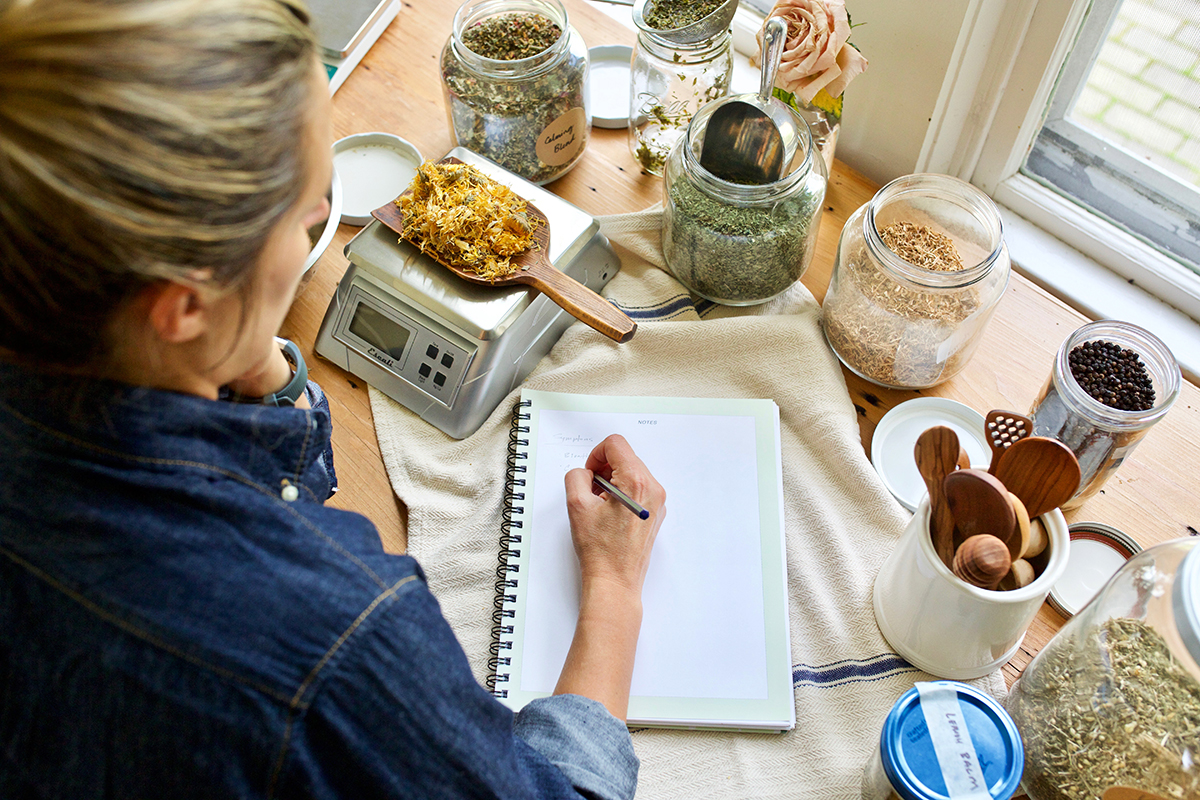
Step 3: Formulation 101
Now that you have selected the herbs you want to use for your gut-nourishing herbal tea, it’s time to start formulating. The steps below offer one simple way you can create a gut-nourishing herbal tea formula (or any herbal tea formula, for that matter).
- Highlight specific actions and energetics of each herb. From your chosen list of herbs, write down the core actions and reasons you want to use each herb in your formula in addition to their energetics (hot, cold, moist, dry). Although this might seem non-essential to some, this step can be very helpful for building a formula that is energetically well-balanced while avoiding too many herbal action redundancies. For instance, if three of the herbs on your list all share similar actions and energetics, you might want to consider taking one or two of them out of your formula. Or if every herb in your formula is extremely drying, you might consider adding a moistening/demulcent herb to help balance the energetics. Consider this step as a chance to have a “final review” of your chosen herbs before moving forward with the rest of your formulation.
- Pick the primary herb(s). By this point, you might already have a hit on what the primary, or leading, herbs in your gut-nourishing herbal tea formula are. Primary herbs are those which support the core or “primary” goal of your formula. The remaining herbs in the formula either help guide the focus of the formula (to a specific bodily system perhaps) or offer some other form of support to the secondary and/or tertiary goals. Although the primary herbs are often the ones used in the greatest quantity as well, they do not necessarily have to be. Typically there are no more than two primary herbs in a formula.
- Choose the proportions. After choosing the primary herb(s), it’s time to start proportioning the herbs into parts. The more you practice building herbal formulas, the easier and more intuitive this step will become! When dividing the herbs into parts, it is important to consider: the energetic balance of the formula (heating vs. cooling and drying vs. moistening actions), the importance of the herbs in your formula (whether they are primary or secondary), and the flavor of the tea blend as a whole and the individual herbs within.
Write down each herb in your formula on a piece of paper, then write how many parts of each herb you would like to use in your gut-nourishing herbal tea formula alongside each herb name. For example: if chamomile is your primary herb, you might use 1 to 2 parts (keeping in mind its bitter and relaxing actions); if you only want to add a touch of cinnamon for flavor, you might only use ½ part. After deciding on each of the individual parts, compare all of the parts together as a whole formula and assess the overall balance. Make any final adjustments as you feel would best balance your tea blend.
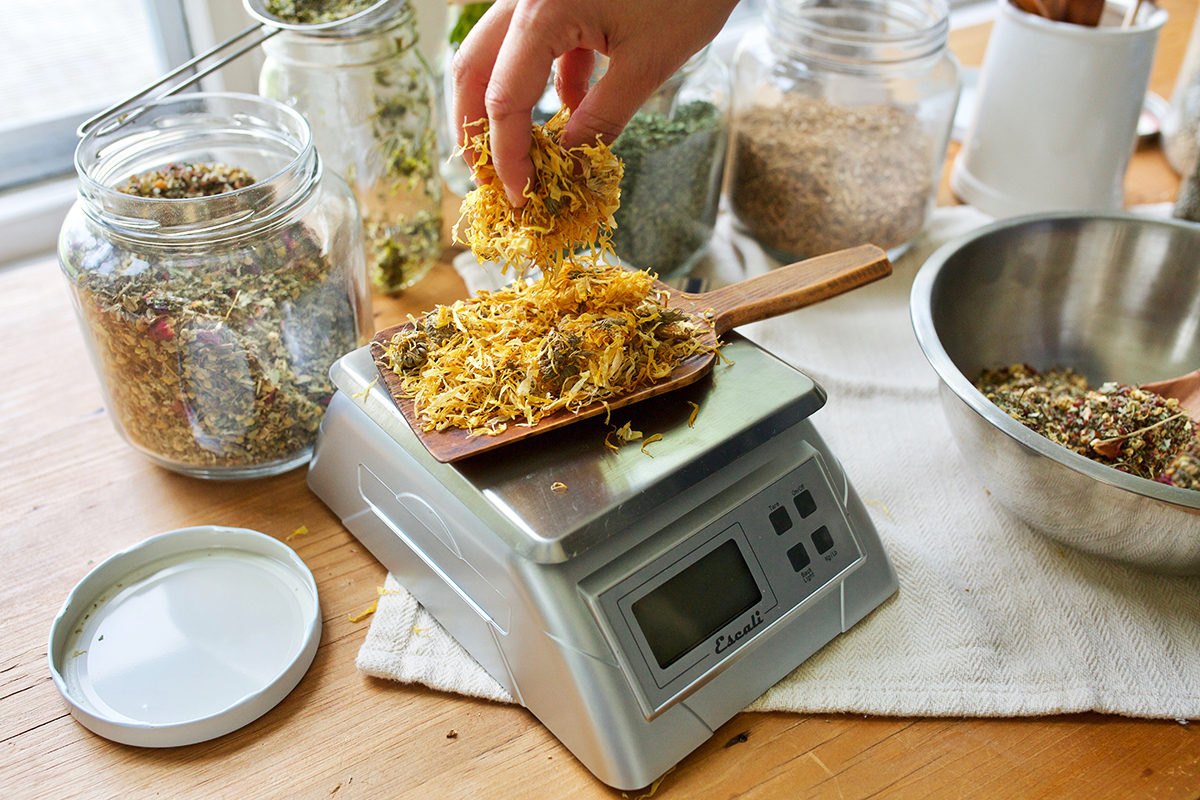
- Calculate the exact quantities (optional). After determining the parts for your gut-nourishing herbal tea, you have the option to stop there and go ahead with blending the formula using measuring spoons and cups for approximate amounts. For those who want their formula to be proportionally exact, follow this last step to calculate the exact amount of herbs you should use.
To find the exact quantities in your formula, start by deciding the total amount of gut-nourishing herbal tea you want to make. Unless you are fairly certain that the tea formula you made is perfectly balanced for you in flavor and energetics, I would suggest starting with a smaller quantity for the first couple of batches you prepare. That way if there is one aspect you would like to adjust after tasting it, you won’t have a big batch of the unbalanced tea blend left over. After you figure out the total amount you want, divide this number by the total number of parts (including the decimal point if you used ½ of a part, for instance). This basic equation gives you the number which you then multiply by each part.
Example: You are formulating a gut-nourishing herbal tea with 1 ½ parts chamomile, 1 part fennel, and ½ part cinnamon chips. This equals 3 parts in total. You want 30 grams total of herbal tea. Divide 30 by 3 to get 10. Then multiply 10 by 1 ½ part chamomile to get 15: you will use 15 grams of chamomile in your formula. Multiply 10 by 1 part fennel to get 10: you will use 10 grams of fennel in your formula. Multiply 10 by ½ part cinnamon to get 5: you will use 5 grams of cinnamon in your formula. 15 + 10 + 5 = 30 grams (your desired total amount of gut-nourishing herbal tea).
Example Formulation
Now that you understand the 3 essential parts to creating your own gut-nourishing herbal tea blend, let’s walk through it step-by-step with a real-life example!
Let’s say you’ve been dealing with a lot of stress lately and your digestion is feeling off. You’re getting bloated after most meals and experiencing a lot of gas and occasional dull belly cramping. A daily gut-nourishing herbal tea sounds like it would help get your digestion back on track.
First let’s set our goals:
- To help alleviate indigestion symptoms.
- To soothe gut inflammation.
- To quell dull cramping in the gut.
Now we can highlight different herbal action categories that would be appropriate to help us reach our goals. Bitters and carminatives are two key categories to help alleviate indigestion symptoms\. For gut inflammation, herbs from the inflammation modulation and vulnerary categories above would both be indicated. If the inflammation and chronic stress picture have compromised the integrity of the gut lining over time, vulnerary herbs are specifically indicated. For the dull cramping, antispasmodics are key! Let’s also highlight the flavor-enhancing herbs category too, just in case we need to incorporate some additional herbs to lend a good flavor for our blend.
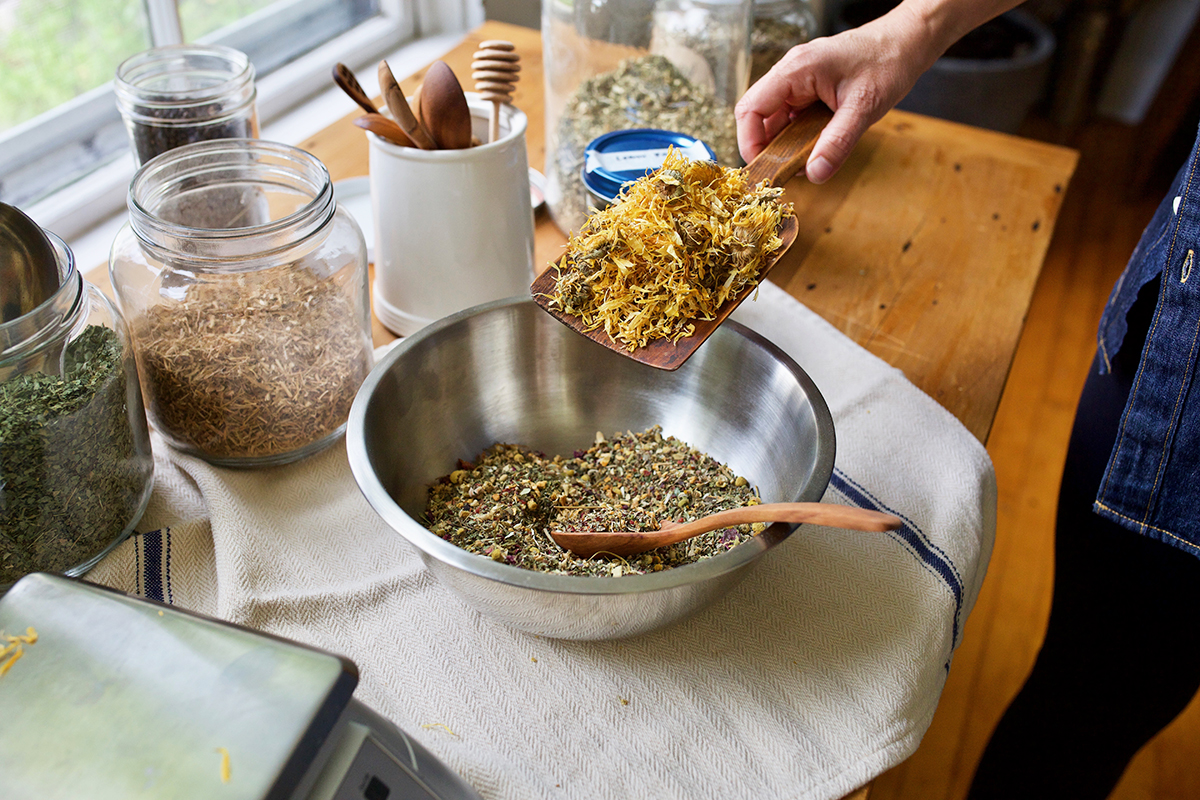
The following digestion-friendly herbs fit nicely into the above categories: chamomile (Matricaria chamomilla), peppermint (Mentha x piperita), fennel (Foeniculum vulgare), ginger (Zingiber officinalis), marshmallow (Althaea officinalis), and calendula (Calendula officinalis) when considering their specific actions and energetics:
- Chamomile: warming and drying; vulnerary, antispasmodic, inflammation modulation, bitter, carminative
- Peppermint: warming and drying; bitter, flavor-enhancing
- Fennel: warming and drying; carminative, antispasmodic, flavor-enhancing
- Ginger: heating and drying; inflammation modulation, carminative, antispasmodic
- Marshmallow: cooling and moistening; vulnerary, demulcent
- Calendula: warming and drying; vulnerary, inflammation modulation
Now it’s time to review our formula and make adjustments! Marshmallow is definitely an essential component given it’s demulcency and moistening action compared to the other drying herbs in the formula. Considering the actions of all of the herbs and the flavor balance of the formula overall, ginger may not be needed. We already receive the highlighted actions from several other herbs and because ginger is so hot and dry, it could potentially throw the formula too far out of balance in terms of energetics.
Based on the actions we highlighted in connection with our goals, chamomile appears to be our leading, or primary, herb. We have several options of herbs to choose from for our secondary herb. Since fennel supports two of our core goals, let’s choose fennel for our secondary herb in this example.
Next, let’s choose our proportions. For this step, it’s helpful to write down all of your herbs on a sheet of paper if you haven’t already. Keeping our primary and secondary herb in mind, I divided the formula into these proportions:
- 1 part – Chamomile
- ¼ part – Peppermint
- 1 part – Fennel
- 1 part – Marshmallow
- ½ part – Calendula
Like I mentioned earlier, choosing your proportions takes some practice and familiarity with the density and nature of the herbs you are working with in your formula. I chose to focus the majority of the formula around chamomile and fennel (recognizing that fennel is much denser than chamomile so even though I used the same number of parts for each herb, chamomile will not be overpowered). Since marshmallow is the only moistening herb in the formula, and this property is important for soothing an inflamed gut, I chose to use a larger quantity of marshmallow comparatively. Calendula I used in a smaller amount since it is quite light and fluffy in density. Peppermint I also used in a smaller amount so as not to overpower the flavor of the formula.
Now that we have our proportions, we have the option to start mixing our tea blend use rough measurements based on parts, or we can calculate our exact quantities. For the sake of this example, let’s determine the exact amounts here.
First we will add up the total number of parts: 1 + ¼ + 1 + 1 + ½ = 3 ¾ (or 3.75) parts total.
Next, we will decide the total amount of tea we want to prepare in grams. Let’s go with 60 grams to start since we don’t want to prepare too large of a batch in case we want to adjust the formula at all after tasting it!
Now we divide 60 by 3.75 to equal 16.
We then multiply 16 by each of our chosen herb parts to get the exact quantities of each herb we will use in our formula:
- 16 x 1 part = 16 g Chamomile
- 16 x ¼ part = 4 g Peppermint
- 16 x 1 part = 16 g Fennel
- 16 x 1 part = 16 g Marshmallow
- 16 x ½ part = 8 g Calendula
For good measure, let’s double-check that our basic math is correct by adding up each of our quantities to ensure they equal 60 grams total.
16 + 4 + 16 + 16 + 8 = 60 grams
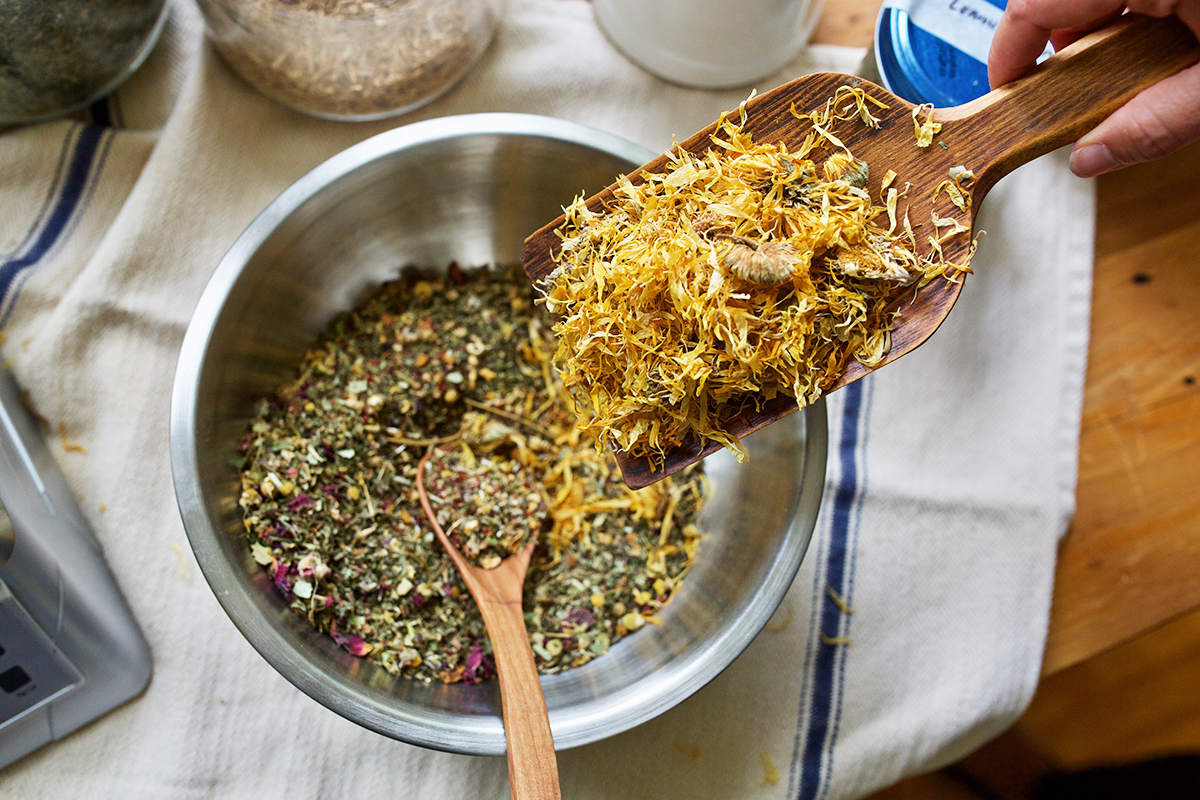
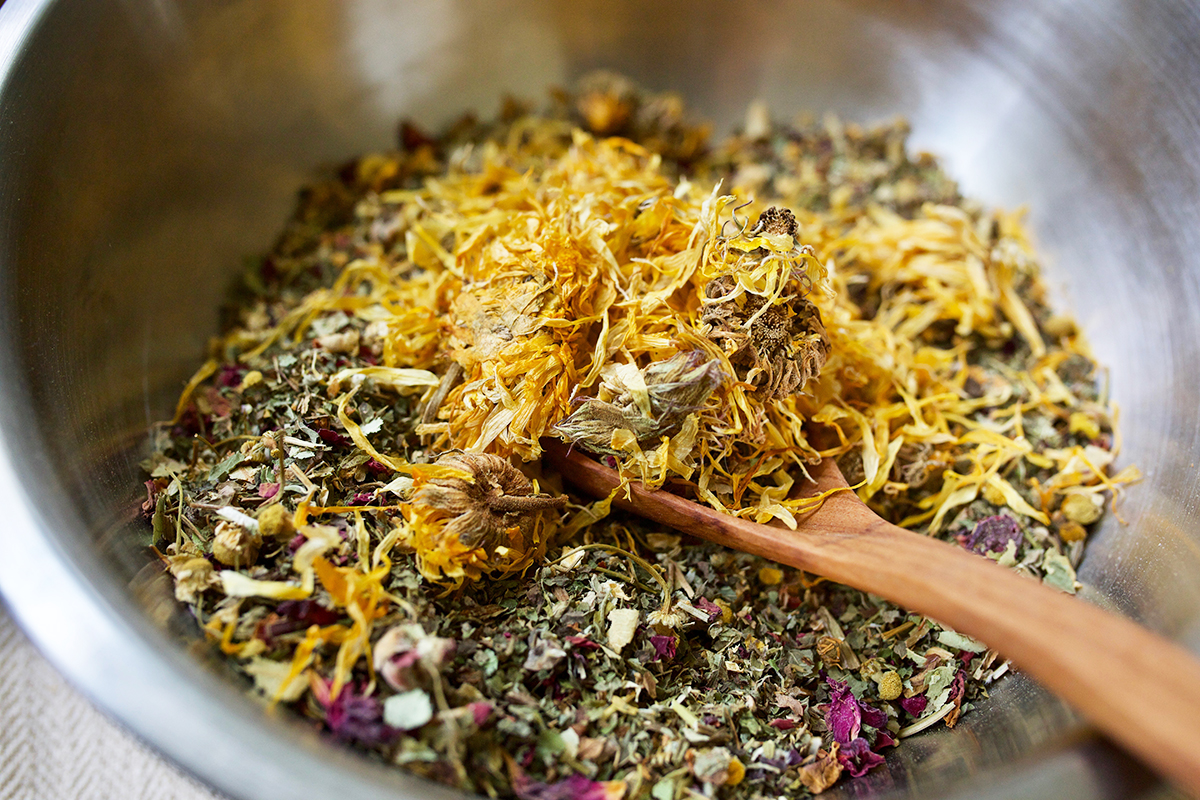
Creating Your Dosing Strategy & Choosing Your Extraction Method
Congratulations! You have just formulated your very own gut-nourishing herbal tea blend. Now that your tea is ready to drink and enjoy it’s time to create your dosing strategy.
Your dosing strategy will be dependent on what your initial goals and needs for drinking the tea formula are. For instance, if you formulated a gut-nourishing herbal tea for an acute gut symptom like a bout of loose stools or constipation, your dosing protocol will be more short-term and perhaps be taken on an as-needed basis. On the other hand, if your gut-nourishing herbal tea blend is designed for supporting general long-term gut health or addressing chronic digestive symptoms from the root, enjoying your tea blend daily is essential. A simple long-term dosing strategy is preparing a quart of your gut tea through either an overnight infusion, standard infusion, or decoction, and drinking daily.
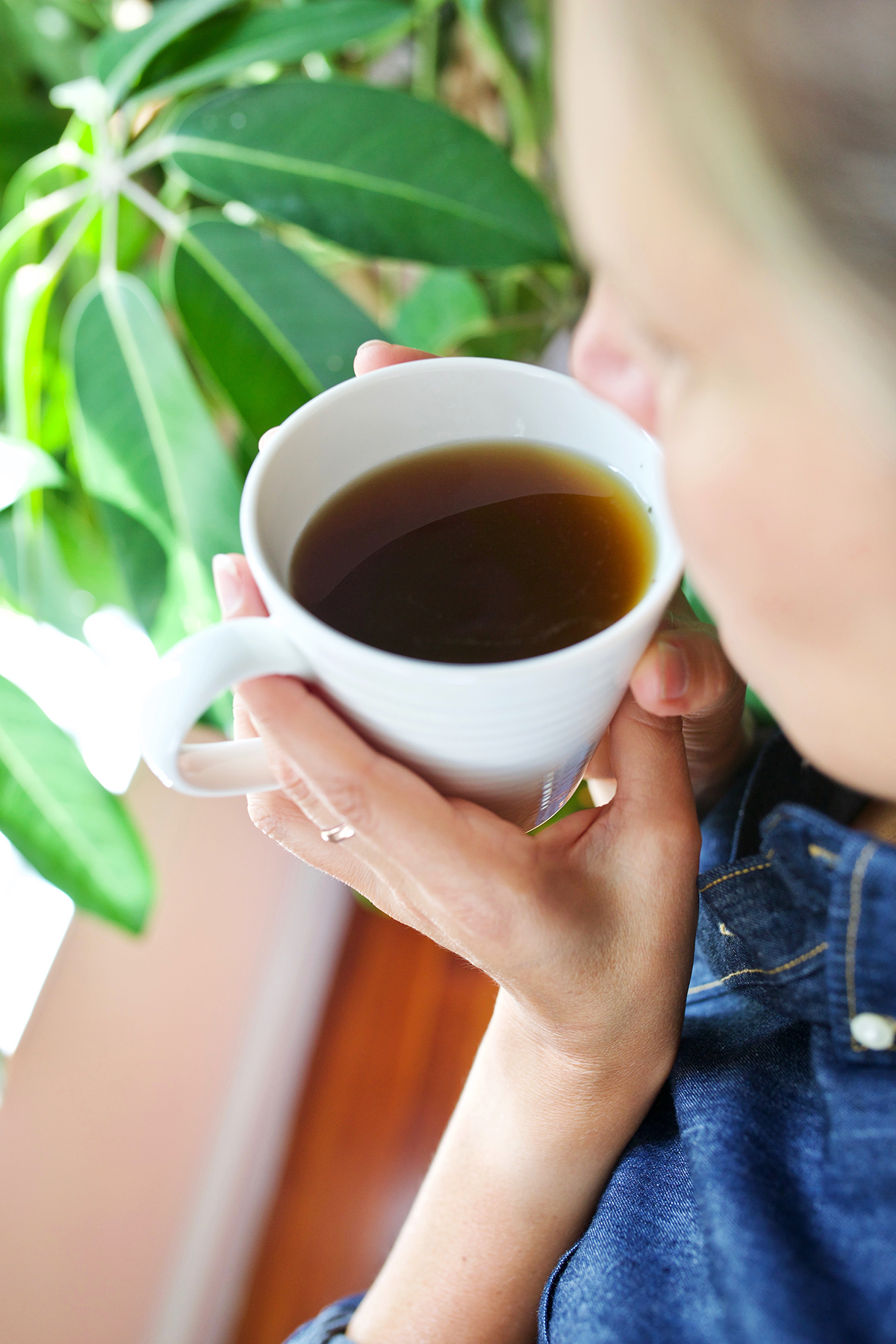
When deciding which extraction method to use, it’s important to consider the bitter qualities of the herbs you are using. An herb like chamomile, for instance, can turn a tea incredibly bitter when steeped for too long. Also, consider the nature of the plant parts you are using in your blend. If you are utilizing heartier plant parts like roots, berries, and seeds, it’s important to prepare them through either an overnight infusion or decoction. Avoid using a decoction method for lighter aerial parts like leaves and flowers and favor either an overnight infusion or standard infusion instead. If you are mixing both aerial parts and heartier parts, opt for an overnight infusion (while keeping in mind the taste and bitter properties as well!), or decocting the heartier plant parts and then pouring that hot decoction over the aerial parts to infuse.
Creating an effective and balanced dosing strategy alongside choosing your ideal extraction method can take some time to perfect. Be patient with yourself and allow yourself to learn from trial and error as you experiment with making different gut-nourishing herbal tea blends over time.
Simple Nourishment
When in doubt, keep it simple. Formulating a gut-nourishing herbal tea blend does not have to be a complicated process! Oftentimes utilizing gentle, nourishing, and “common” herbs like chamomile, peppermint, plantain, and marshmallow is just what an inflamed and unsettled gut needs to get back into balance.
Curious to learn more ways you can use herbs to support the gut? Promote healthy gut flora by making prebiotic herbal electuaries in our post here.
